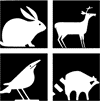Center, Internet, Wildlife Damage Management

Wildlife Damage Management Conference Proceedings
Date of this Version
2005
Document Type
Article
Abstract
Bovine Tuberculosis (bovine TB) in northern Michigan has proven a dilemma necessitating aggressive measures including depopulation of livestock operations, culling of wildlife, banning the feeding of wildlife, and fencing livestock feed with high fences. Bovine TB is believed to be transmitted from white-tailed deer (Odocoileus virginianus) to domestic cattle through feces, urine, saliva, and nasal secretions on contaminated feed (indirect transmission) and from animal to animal (direct transmission). Effective methods for excluding deer from cattle enclosures would minimize the potential for indirect and direct transmission of bovine TB between infected deer and cattle. We combined an idea used historically in Europe to control predation on sheep with the concept of modern frightening devices that often fall short when the motivation of offending species is high. The use of livestock protection dogs (LPDs) seemed like an ideal solution in controlling the transmission of bovine TB from white-tailed deer to cattle.


Comments
Published in Proceedings of the 11th Wildlife Damage Management Conference. (D.L. Nolte, K.A. Fagerstone, Eds). 2005.